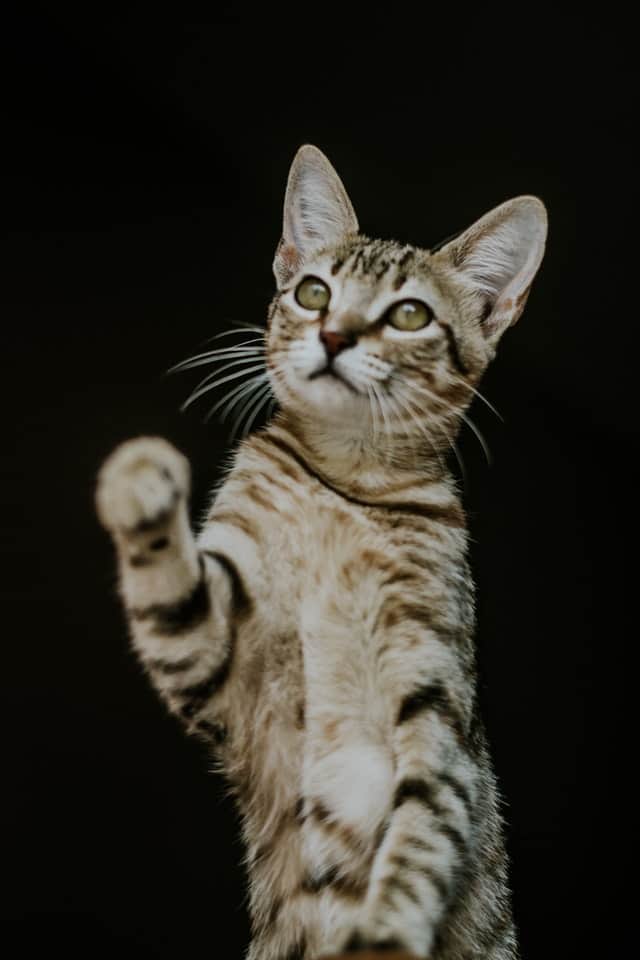
The black-footed cat has nothing to do with the famous and very nice Puss in Boots, indeed, if we want to be honest here, the black-footed cat is not at all nice given its solitary and also particularly aggressive habits. The black-footed cat is by definition not very sociable and is known as the “anthill tiger” – This nickname immediately makes it clear that we are not dealing with a kitten or a placid cat, but with a feline that has a strong character and a very aggressive disposition. Not towards man but towards several animals even bigger than him. Reckless and ferocious, if threatened, it seems to go to attack also giraffes and animals of similar size.
Black-footed cat: characteristics
Despite its courage, the black-footed cat is not a feline of the XXL size, indeed, it is defined as the smallest African feline. Its body is 36 to 50 cm long, the tail is added and can measure from 18 to 26 cm, approximately. The weight of such an animal, with a rather slender structure, is about one and a half kilograms even if a lot depends on the sex of the specimen we are observing. Males, for example, can weigh up to 3 kg but not much more.
Among the characteristics of our cat we do not take for granted the color of his feet, that is of the paws, dark by definition, as it is also obvious that it is, the rest of the coat is not black but can be of different shades. Black feet with a tawny gold color with black spots or others with spots more tending to brown shades.
As a mammal, our cat is classified among felines, carnivorous and not suitable for domestic life as we will verify.
Black-footed cat: breeding
There are two subspecies of black-footed cats but neither is suitable for breeding, let alone being housed indoors. It is also true that such an animal is not very widespread but it is difficult to evaluate it because it leads a reserved life and does not like to come into contact with humans. The two subspecies mentioned are the Felis nigripes nigripes and the Felis nigripes thomasi, they are not so dissimilar and at the level of behavior they have identical traits.
The farms of both are rare to meet, it is better to go in search of specimens of black -footed cats where it lives: in Botswana, Namibia and South Africa, in general it prefers arid areas and where it can go hunting of mice and insects, at night, his favorites.
Black-footed cat: kittens
In addition to not wanting to see men, these cats are not even very social with each other, the mating lasts a few hours and occurs only in the right season, the female remains in heat only a day or two and everything takes place without much courtship and without any romantic sequel. Other than the Aristocats!
Even after gestation, as soon as the puppies come to light they are weaned very quickly so that they can get away with it on their own or at least as soon as possible. The female of the black-footed cat can reproduce twice a year and, living in an inhospitable environment, each time has to work hard to make sure that her offspring survive the first months of life, when it is totally or almost totally dependent on her.
As adults, black-footed cats live mostly at night, being very lazy during the day. As soon as the darkness comes they go wild and become very aggressive, their way of doing is undoubtedly that of a wild predator, other than kittens.
When it comes to hunting, a black-footed cat manages to kill up to 14 prey per night (about 250 grams of meat), moreover the males mark the territory even a dozen times in an hour.
Domestic black-footed cat
You can guess it but better write it plainly: the black-footed cat is not a pet and it is practically impossible for it to get used to being with a human being in an environment that is not what it is used to.
Although it is not very hospitable, cats habitat has water and prey to feed them and it can get along well with their nocturnal hunt. Among its preys we find animals of unexpected dimensions and types, such as skunks, small mammals, but also birds, reptiles and insects. Cat does not always hunt with the same technique but loves to amaze and take over his prey in always different ways. Sometimes it chases his prey, other times he ambushes them, still other times it pretends to be disinterested and then moves on to direct attack.
For those who want a domestic black-footed cat there are various alternatives, they can adopt a stray one, choosing it by sifting through the color of the paws, or they can buy a soft toy online, contenting themselves with an all black cat, instead of with only the paws of this beautiful color. If you want to get to know some other non-domestic cats check out the Norwegian Forest cat and the Serval cat, for example.






